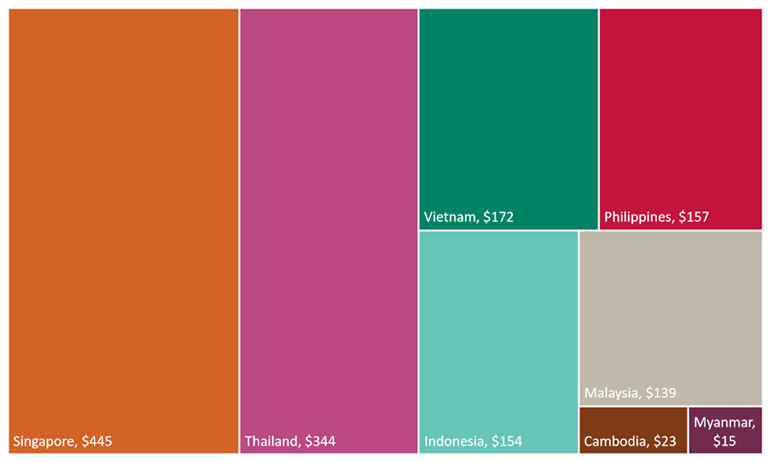In 2022, Australian wine exports to Southeast Asia grew by 16 per cent in value to $305 million and 56 per cent in volume to 27 million litres. In light of this growth, and Vinexpo Asia taking place in Singapore in May 2023, this Market Bulletin will be the first in a two-part series examining the region, with today’s part one looking at recent trends in the region as a whole. Part two will focus more closely on insights into key markets in the region.
Emerging markets driving economic growth
Southeast Asia is a diverse group of markets, home to more than 686 million people, about 8.6 per cent of the world’s population. Indonesia and the Philippines are the most populous, followed by Vietnam, Thailand, Myanmar, and Malaysia. As a whole, these markets represent a significant opportunity for Australian wine due to their population size and economic growth.
Singapore is the only market classified by the International Monetary Fund as an “advanced economy” in Southeast Asia, while the rest are classified as “emerging”. Although the emerging markets currently have lower GDP per capita levels, their wealth is expected to grow at stronger rates than developed economies over the next few years (see Figure 1).
Figure 1: GDP per capita growth rates, Southeast Asian markets versus advanced economies

(Source: IMF)
While the Southeast Asian economies were all heavily impacted by the COVID-19 pandemic, thanks in part to their reliance on tourism, in recent times their exposure to rising inflation has been muted compared to other world regions (see Figure 2). The IMF is estimating inflation rates between 3 and 6 per cent in 2022 for most of Southeast Asia, with that being the peak for most markets, although Indonesia and Vietnam are expected to peak in 20231.
Figure 2: Annual inflation rate by region

(Source: IMF)
Wine consumption took a hit during 2020 – now forecasted to grow
As a whole, Southeast Asian markets represented 6.7 million 9-litre cases of wine sold in 2021, valued at US$1.4 billion in retail value. This ranks the group roughly around 43rd in global wine markets by volume but ranked 25th by value. Driving this result is the high average value of wine sold in these markets – an average of US$17.88 per bottle overall compared to US$9.46 in the United States, US$11.67 in the United Kingdom, and US$9.10 in Australia. However, this high average value is partially driven by high taxes on wine in some of the Southeast Asian markets.
Wine consumption fell for these markets as a group during 2020 as a result of the COVID-19 pandemic restricting tourism. There was a small recovery in 2021, growing by 1 per cent in volume and 5 per cent in value. Looking at projected growth to 2026, IWSR is forecasting 7 per cent growth in volume and value on average per annum. Driving this growth are rising incomes, the return of tourists, and a growing appetite for good quality alcohol2.
Figure 3: Wine consumption in Southeast Asia

(Source: IWSR)
Singapore is the largest wine market in Southeast Asia and is classified as a “growth” market by Wine Intelligence – meaning wine is a mainstream product and/or experiencing growth. All other significant markets in this region – Thailand, Vietnam, Philippines, Indonesia, and Malaysia – are classified as “new emerging”, where wine is a new product but showing potential.
Figure 4: 2021 value of wine consumption by market in Southeast Asia (Million USD)

(Source: IWSR)
Although Singapore has a smaller population than most of the other markets in this region, its larger size as a wine market is driven by the fact that Singaporeans drink nearly ten times as much wine per person as the other markets (although still much less than wine drinkers in Western developed markets). In 2021, adults in Singapore drank 2.6 litres per person, while Malaysia, Philippines, and Thailand all hovered around 0.2 litres (see Figure 5). Indonesia has an even lower wine consumption per capita – at 0.03 litres per adult – but it’s large population still makes it a similar size wine market to the Philippines.
Figure 5: Litres per capita (adult) wine consumption by market

(Source: IWSR)
Australian wine exports grow to a record level
In the year ended December 2022, exports to Southeast Asia increased by 16 per cent in value to $305 million and 56 per cent in volume to 27 million litres – a record level. There are 461 exporters shipping to the region, a 7 per cent increase compared to the previous year. As a group, Southeast Asia is worth more in value than the Canadian market for Australian wine exports, but less than the United Kingdom.
Figure 6: Australian wine exports to Southeast Asia

(Source: Wine Australia)
Exports to all key Southeast Asian destinations increased in value, with the exception of Singapore. The main drivers behind this growth were Thailand (up 118 per cent to $62 million) and Malaysia (up 78 per cent to $61 million). A decline in the value of exports to Singapore, down 20 per cent to $132 million, offset some of these gains. Singapore remains the number one destination in Southeast Asia for Australian wine exports but is a trading hub and some of the wine is on-shipped to other Asian markets.
Figure 7: Exports to Southeast Asia by market (million litres)

(Source: Wine Australia)
